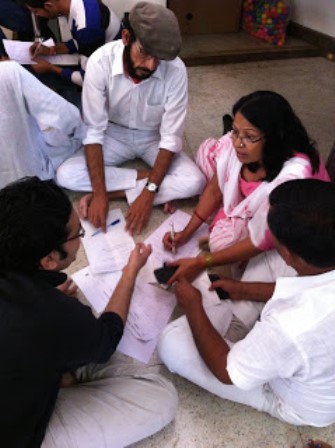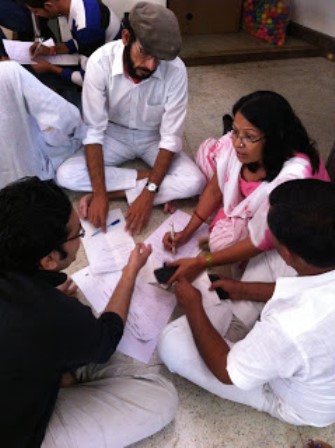Farmers leaders from 12 countries gather in Bangalore for a seminar on Peasant Struggle In India

 (Bangalore, India, October 31, 2015) On the 28th of October, the International Seminar on Peasant Struggle in India was held at Samvada in Bangalore, India, organized by La Via Campesina South Asia. This seminar kicked off a ten-day Zero Budget Natural Farming seminar and training, which would continue from October 30th- November 5th at Amritha Bhoomi (LVC Agroecology school). It brought together activists from across the globe. Bharatiya Kisan Union (India), MONLAR (Sri Lanka), ANPFA (Nepal), Bangladesh Krishok Federation (Bangladesh), Black Sea Uprising (Turkey), SPI (Indonesia), Assembly of the Poor (Thailand), ZIMSOFF (Zimbabwe), MVIWATA (Tanzania), MST (Brazil), and Boricuá (Puerto Rico) were all represented.
(Bangalore, India, October 31, 2015) On the 28th of October, the International Seminar on Peasant Struggle in India was held at Samvada in Bangalore, India, organized by La Via Campesina South Asia. This seminar kicked off a ten-day Zero Budget Natural Farming seminar and training, which would continue from October 30th- November 5th at Amritha Bhoomi (LVC Agroecology school). It brought together activists from across the globe. Bharatiya Kisan Union (India), MONLAR (Sri Lanka), ANPFA (Nepal), Bangladesh Krishok Federation (Bangladesh), Black Sea Uprising (Turkey), SPI (Indonesia), Assembly of the Poor (Thailand), ZIMSOFF (Zimbabwe), MVIWATA (Tanzania), MST (Brazil), and Boricuá (Puerto Rico) were all represented.
“Monsoon Game”
The program kicked off with an interactive learning exercise that introduced participants to the lives of farmers in India today. Participants were grouped into “families” of three or four people, who were then given a slip of paper with their family details. One family’s members were powerful landlords with many acres and a lot of money in savings, another family consisted of landless laborers with very little income, and another family’s members were shopkeepers who owned no land but had monthly income from their business.
Depending on the assigned family’s source of income and landholdings, the groups had to work together to plan what crops to grow, decide whether to take loans, whether to put in a bore well, and when to marry their daughters, all based on a sheet of paper that gave details about rainfall, crop productivity, loan interest, etcetera by which the families could do their calculations. The participants did this for three annual cycles, and each year the program leaders would announce a new set of pitfalls and boons that would alter the stakes – for instance, one year a family lost their house due to road widening, and a landholding family received a boon when a lake was built near their property. During the exercise, the room was abuzz with careful concentration, joy at a boon, and frustration at hardship. The goal was to illuminate the multifold challenges that farmer and other rural actors face, and the unequal distribution of power along caste, class, religion, and gender lines. By the end, some families had increased their money two-fold, while others had died of hunger, or were hundreds of thousands of rupees in debt.
The question asked by participants was, how real is this exercise? Anita, the event’s host and founder of Samvada, answered this question by sharing facts about agriculture in India that were reflected in the exercise: for example, 78% of farmers in India today own less than 5 acres of land. She also shared the most recent statistic that more than 250 farmers have committed suicide this year in this state alone. This is where Samvada enters the picture – they offer courses for young people from farming communities on how to make agriculture profitable and also economically sustainable. The ultimate goal is to make farmers proud of their profession, and to encourage an agricultural system that benefits farmers and the environment.
Agrarian Crisis: Dr. A.R. Vasavi
The challenges faced by farmers were further illuminated in Dr. A. R. Vasavi’s lecture on agrarian distress in India. Dr. Vasavi, an eminent social anthropologist, explained that since 1997 there has been a rise in farmer suicides in several districts in India. While news media have focused on two extremes to explain this rise in suicides, international trade agreements and psychological weakness on the part of the farmers, she argues that we need to understand the complexities of rural experiences on-the-ground to truly understand this devastating trend. Her talk provided very detailed and informative insight into farmers’ lives, including a discussion of the role of commercial agriculture in flattening regional variations in agricultural practice, the observation that while local knowledge systems are on the decline, caste inequalities remain strong in rural communities, and the contradictory trends of “accumulation by dispossession” and “welfare governmentality.” All of these trends lead to farmers becoming trapped in a “web of risks” that take many forms, such as low access to institutional credit and the high prevalence of debt (and the social humiliation related to the inability to repay loans), and production risks related to failed rains and climate change. These trends have led more and more farmers to leave agriculture and have also resulted in the “disorientation” of youth caught between farming and desires for lives outside agriculture. Despite these seemingly insurmountable challenges, Dr. Vasavi emphasized the positive potential of rural communities as participants in the democratic process, since villages have higher voting rates than cities. She also stressed that farmers are productive “innovators” as well as a “repository of local and sustainable knowledge systems,” and should be respected as such. Dr. Vasavi’s lecture communicated both the problems and potentials of rural communities in India today.
History of Peasant Struggle: Dr Muzzafar Assadi
Dr. Muzzafar Assadi, an eminent scholar on social movements and Professor at Mysore University, then shared with the group the history of farmer’s movements in India. He began by explaining why social movements in India use the term “farmer” rather than “peasant,” sharing a long history of public policy and state intervention in India that led most cultivators to focus on surplus production for the market rather than subsistence. In illustrating this point, he gave an introduction to the history of agricultural policy in India, which focused on increased production for food self-sufficiency, coming to a head in the Green Revolution of the 1960s. This led up to farmer’s movements that began in the 1980s and picked up pace in the 1990s, which are often called “New Farmers’ Movements.” He explained why: these movements were not the first farmer’s movements in India, as India has a long history of farmer agitation, such as the 1970s farmer action in political rallies. However, while the movements that began in the 1980s and gathered steam in the 1990s were not “radical movements” in terms of their ideologies, strategies, and politics, they were “new” for several reasons: 1) they believed in class harmony rather than conflict, 2) they never invoked caste categories, and 3) they were never localized movements, in that they were immediately active in crossing regional boundaries to make inter-state and also international allegiances. The primary point around which many of these movements were organized was resistance to globalization, which took different “post-Gandhian” forms such as laughing in front of the centers of government power and storming of a KFC restaurant in Bangalore. They offered an alternative to globalization of the “khadi curtain,” which focused on indigenous growth. Despite the power of these movements in the 1990s, however, Dr. Assadi said that these movements have dwindled significantly, and today are no longer strong in the way they once were, largely due to splits between movements. However, he suggested that we should thank these movements for giving us the space to debate globalization and imagine alternatives.
The seminar proved to be a fruitful platform by which to learn about and discuss the challenges and potentials of agriculture in India today. The participants departed with energy and enthusiasm for tackling the multifold problems and opportunities of global peasant struggle.
